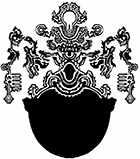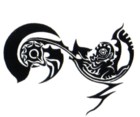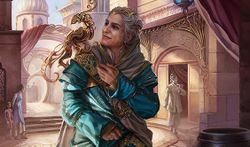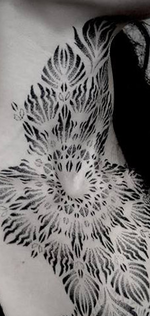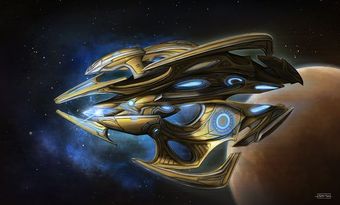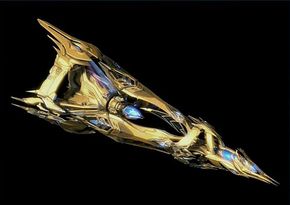El-Aurian
| Intelligent Lifeform Index |
|---|
| El-Aurian | |
|---|---|
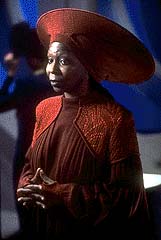
| |
| Four Letter Code | ELAU |
| Federation Status | Neutral |
| Planet of Origin | El-Auria |
| Encountered | Star Trek TNG & Star Trek Generations |
| T/E Rating | T0/E0 |
| Current Tech Level | N/A |
| List of Named El-Aurians | |

| |
Full ILI Gallery • Permitted Species Gallery | |
El-Aurians are a long living, ancient race from the El-Auria planetary system located near the border of the Beta and Delta quadrants. Very little is known about their origins, however circumstances as to how they became a dispersed humanoid race is well documented by survivors. El-Auria, which is now well-within Borg space, was infiltrated by the Borg in 2265. The Borg invasion and assimilation of their system forced the surviving El-Aurian race to flee and disperse throughout the galaxy as displaced refugees and wandering nomads. Many, if not all, surviving El-Aurians have found their way into the Federation territories and soon into the ranks of Starfleet, although seldom, if ever, in positions of leadership as they usually prefer to operate quietly in support positions.
Physiology
Physically indistinguishable from Terrans, El-Aurians are regarded as a race of 'listeners' with exceptional communication skills. They have a lifespan of several centuries and age very slowly - a 200 year old El-Aurian could easily pass as a youthful 20~30 year old Terran. Due to their long lifespan, they have a low reproductive rate compared to other species, and take longer to be socially considered mature; only around 40 or 50 is a growing El-Aurian considered fully adult, with the decades before that compromising their adolescence.
El-Aurians are extraordinarily sensitive to disturbances in the space/time continuum, and will usually remember the original version of history if a change is made in time. It is unknown if El-Aurians possess any emphatic or telepathic abilities, but the generally-held theory is that most don't.
The hippocampus (which stores memories) of the El-Aurian brain is extremely dense having about 10x the normal neural pathways allowing for greater storage of memory. Furthermore, it is linked to both sides of the brain with even stronger connections to their auditory senses. The extensive networking of neurons in the hippocampus are not present at birth but develop at puberty and continue to grow until the end of puberty.
El-Aurians are prone to eidetic memories ( about 60%) of their race. 58% of these eidetic memories do not develop until the onset of puberty. The way that humans can use scent to trigger memories, El-Aurians have a stronger trigger to recover memories with auditory stimulus. When they remember things they have a fuller and more robust mental image.
Genetically, El-Aurian genes and traits are dominant when breeding with other humanoids, however the passing-down of their trademark longevity and their ability to perceive space/time continuum disturbances remains unstudied and unverified.
Culture and Society
El-Aurians are natural lore-keepers, and use their phenomenal lifespans and memories to collect the stories and life experiences of various sentient beings. They preserve this knowledge for their own kind, and only occasionally share it with non-El-Aurians. They are considered a race of natural ‘listeners’, and their long life spans and powerful memories have given them a reputation for insight and wisdom.
Their long lifespan has had one major effect compared to other races - their culture took quite a long time to effect social change. Their generations were centuries between each other, and as such old traditions became ingrained deeply.
Art, Arcitecture and Fashion
El-Aurian art is notably nonfigurative, with most of their art being patterns of flowing, interwoven lines. They tend to favor strong, dominant colors with only a single accent; much of their tech was white with blue accents, their clothing one color with a slight underlay of another. Decoration tended to come in various shadows of the dominant color or in patches of pattern or textured fabric.
Hats were common among El-Aurian women, and were typically large, covering much of the head and hair. Even when not wearing hats, having a decoration woven into their hair was more common than not.
The El-Aurians have a reverence for light in all its forms, and their homes are often designed to allow for the travel of sunlight. Spiritual and private rooms are often decorated in candles or small lamps. Their buildings were often built deeply into nature and supported in the tall canyons of El-Auria, so that even the most technically advanced buildings were filled with light and the sounds of nature.
Religion
Little is known of formal El-Aurian religion, as few speak of it to outsiders. They seem to follow female figures, however, with many of the El-Aurians praying to a single Goddess figure. Even the Eccia, who worship the Three, see their deities as entirely female.
Subculture - The Eccia
The Eccia were an El-Aurian culture that lasted the length of El-Auria’s history. Descendants of a tribal structure in the planet’s southwestern hemisphere, they began as semi-nomadic tribes in the arid regions of the world.
Their religion was one of personal and cultural goals. They believed their founders, the Three, had once been mortal as they were, before each found a way to transcend beyond their mortal body. The clan leaders traced themselves as direct descendants of these figures: Tenera, Cantavi, and Venoja. They were strictly matriarchal, with a noble class of the most pureblooded women leading their clans. As history pressed on, these clans grew until some several million of the Eccia populated El-Auria.
Due to the philosophies supposedly set down by their Goddesses, the three clans (or Houses, as they would come to be known) often found themselves at odds, and even into relatively recent El-Aurian history had no issue solving these conflicts over land, resources and ideals through violence.
As the global culture began and the overall El-Aurian culture began to homogenize, the Eccia kept their long history of clan warfare and modernized it; pitched battles turned to blackmail, assassination and careful defamation. What they became famous for among the other El-Aurians was their most infamous trait: To kill the current head of the other Clan was absolutely forbidden. Even if they disagreed with their philosophies, all tribes agreed the Three were sacred and their bloodline should not be severed. What was not forbidden was killing the children of the Clan leader, and to do so was considered one of the most effective ways to attack the other clans. For this practice, they’ve gone down in general El-Aurian history as being babykillers.
By the Assimilation, the Eccia maintained significant power, and the multi-stellar corporations run by them produced the majority of El-Aurian ships and technology. Their stamp can still be seen on much of what remains.
The Houses
The Houses - or clans - rose from the tribes who followed the Three, each choosing to follow the creed of one of the Three. Tracing their clan leader's lineage back to the Goddesses, the Eccia believed their leaders to be the literal blood of gods, and that through the paths taught by the Three, they too could one day transcend to a higher level of existence.
The words used to describe each of the Three - Silence, Speech, and Song - were taken quite literally, with each group having a fully described Path given in each format. These were closely guarded secrets, the full version supposedly only known to each Clan leader. In theory, the path would be passed down when its tenets had been met.
The First House: Venoja
Descendants of Venoja, the Daughter of Silence
The Venoja were the most mysterious of the Houses. They followed the word of transcending through observation and learning, but believed that such things should not be taught to others; they kept their secrets within their own house. They sometimes took vows of silence or, in extreme cases, cut out their tongues entirely. Their clan leader, known as the Silent Sister, traditionally never spoke in public.
Their goal was enlightenment through the realization of self. They believed the ability to transcend existed in El-Aurians by nature, but could only be reached by those who entered into the correct mental state.
While sometimes discounted by outsiders as the passive house, the reality was they maintained their power through a complex dance of alliance and information trade. They observed both of their rival houses closely, though by the end of the El-Aurian world they had come to be more closely allied with the Cantavi due to the Cantavi’s emphasis on progress.
The Second House: Tenera
Descendants of Tenera, the Daughter of Speech
The House of Tenera was perhaps the strictest of the three, with a creed of ‘Tradition, Tutelage, Transcendence’. They believed one could achieve transcendence through the old ways of the El-Aurians and kept to a strict hierarchy and religious structure. The Second and Third houses often clashed over their opposing ideals, but the Tenera were by far the more diplomatic of the two, cultivating a house of teachers and speakers. They were the most favored house by the other El-Aurians, as on the surface they showed a calm and dignity that contrasted their sister houses.
They believed that their Goddess, Tenera, had learned her ability from her forefathers; thus they hunted through the history of their people and looked back, rather than forward.
Under their peaceful exterior, however, they had degraded over the millennia as the others had - their peaceful notions firmly underlined with a dangerous zealotry by the time the Borg arrived. They were by far the House with the biggest emphasis on maintaining the caste and nobility structure of the Eccia, and they shed blood to ensure it. Change had gone from being something only undertaken when it could be argued for to something corrupting and divergent from their Path.
The Third House: Cantavi
Descendants of Cantavi, the Daughter of Song
With a creed of “Innovation, Inspiration, Improvement”, the Cantavi were a House focused on the betterment of thought and technology, with the goal of transcending the mortal form through enhancing the mind and body past what evolution had allowed. Millennia ago this took the form of discovery and vast scientific progress; in El-Auria’s last era of high tech starships and interstellar commerce and travel, this began to degrade into a creed of progress for its own sake and an ideal of being better than their competition.
They bred an environment of ruthless corporate business, spying, blackmail, assassination, and immense wealth. Their relentless drive towards improvement put them at the forefront of El-Aurian technological development by the time the Borg came, their specialties being in starships, cyberwarfare, robotics, and cybernetics. Their ethical creed was always malleable at best, and they carefully kept a lid on the practices of their research labs.
Cantavi-born nobles had personal defense and attack robots, known valiantly as Guardians or Vanguards. These were incredibly common and bound to their charge though the user's cybernetic enhancements. They took many forms, with the Daughter having several that amounted to battleships in their own right.
Their most famous invention is the Obbligato class sloop, a large ship that can be controlled by a single mind. What possibilities it could have led to remain unknown, as it was shortly after it was created that the Borg came.
Art and Culture
The Eccian approach to art was rather distinctive to them, a result of their long history as a separate culture. They had a particular emphasis on beauty; anything of worth ought to be beautiful, no matter its function. Robots, ships, architecture and music should strive to be as elaborate and artful as possible.
This often came at the cost of practicality, as some would see it; Eccian starships and robots often communicated and interacted musically, this method being maintained over millennia due to the pure art of it.
Body Modification
One of the strongest Eccia traditions was body modification through extensive tattooing and piercings. As in many cultures, the sort of jewelry worn and the materials used acted as signals of status, wealth, or accomplishment. The tattoos and jewelry worn were generally split along gender lines, with women typically wearing elaborate earrings, necklaces, and jointed rings decorated with geometric shapes and gemstones. Men typically wore facial piercings, necklaces and bicep rings, the most common jewelery being piercings on the bridge of the nose.
For men, the types of metal and material used sent simple messages - silver and obsidian marked one as unmarried, while gold and white-gold marked them as married. In all genders, the more elaborate the piece, the higher in status they were - namely, within their family.
Tattoos were a careful set of signals, as well, their placement, size and form meant to mark accomplishments, major life markers, and social queues like sexual preference and - of course - house.
Castes and Gender Roles
With a hierarchy based on bloodline, Eccians fell into places in society based on their blood purity; while marrying closer to the full bloodline helped with rising in the ranks, marrying outsiders was considered unwise. Despite this emphasis on blood, however, the lower castes practiced a society of open relationships, with marriage being an arrangement considered unusual. Most of the Eccia happily had multiple partners, and to be exclusive was considered unusual.
However, the Eccia contrasted the otherwise egalitarian society around them by being strictly, even fervently, matriarchal. With their leaders and gods all being female, men played a supportive role in their society, being seen as less suited to the roles of leadership than women. Mothers in particular played the major role in Eccian society, controlling their family. At the higher levels of Eccian society, the leaders frequently had multiple husbands, and unlike those in the lower castes, their husbands were bound to their wife and expected to remain monogamous to her.
Clothing and Fashion
It was traditional for each of the houses' fashion to be dominated by their colors. For the Venoja these were red, bronze and gold; for the Tenera they were blue, yellow and purple; and for the Cantavi they were white, black, and blue. Their clothing, technology, art and tattoos were dominated by variants on these colors.
With their native lands having been arid and dry in ancient times, the traditional Eccian forms of dress were lighter on fabric than those of their northern brethren, and often showed more skin. As a culture comfortable in its sexuality and eager to show off their extensive tattoos and jewelry, it was typical of Eccian clothing to have plunging necklines, bare shoulders and arms, and bared feet. An entirely bare chest was very common in casual clothing, regardless of gender.
Technology
Eccia-created technology is rather distinctive from other El-Aurian tech, though the emphasis on light remains. Spearheaded by the Cantavi, their technology pushed the limits of their capabilities. They created cybernetics, robotics and starships that were the envy of the Delta quadrant; their shapes carved into art as well as being fully functional.
The most common feature of their technology was hard light - a form of light projection that gave it dimension and force, it could be formed into a myriad of shapes and purposes. By the end of the El-Aurian homeworld, it was used in everything from the latest weapons and ships to things as simple as jewelry and clothing.
Notes
- The Eccia content is non-canon, and was created for UFOP SB118.
- Image sources for this article include Endless Space (©Amplitude Studios), Mass Effect (©Bioware), and Drakengard (©Take Two Interactive)

